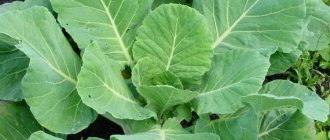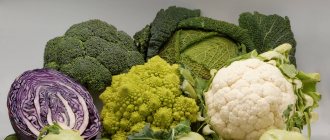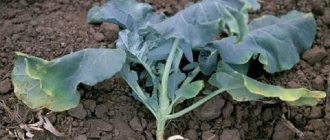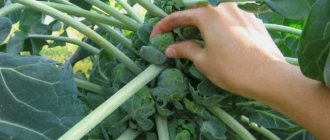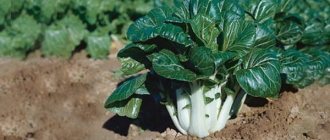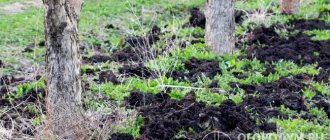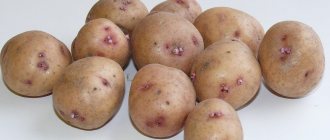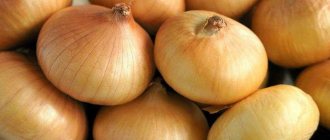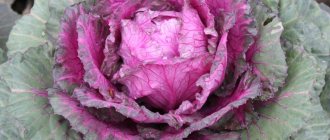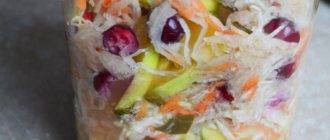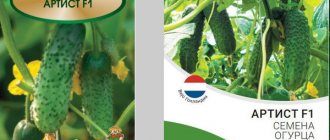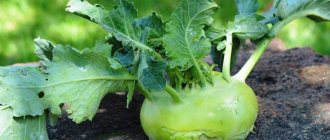What is it - botanical description and characteristics
Cauliflower is an annual plant, winter or spring, belongs to the Cruciferous family, order Brassicaceae.
It has a fibrous root system and a noticeable, up to 70 cm, stem; the leaves are arranged horizontally. In primitive forms of the vegetable, the part used is represented by fleshy flowering shoots located separately; in other forms it is the “head” - tightly twisted apical shoots. The head can have a variety of colors. After ripening, some shoots along its edge grow, form buds, and then flowers and fruits with seeds. This variety of cabbage has a rather low reproductive capacity.
Requirements for soil and predecessors
Cauliflower prefers heavy, moist, fertilized soil of normal acidity containing lime. It can be podzolic chernozem or medium loamy soil. Having determined a place for growing cauliflower, in the fall, during digging, you need to add mineral or organic fertilizers or dolomite flour, ash, and lime to the ground. Among the mineral ones, you can choose nitrophoska. It is added at the rate of 2 tablespoons per 1 m².
Predecessor table
| Desirable predecessors | Unwanted Precursors |
| Nightshades (potatoes, tomatoes), onions, cucumbers, beets, legumes | Plants from the same group - cabbage of all types, radishes, turnips, rutabaga, radishes |
As for the duration of growing cabbage in one place, it is believed that the break between two plantings in one bed should be at least five years. This is explained by the fact that bacteria characteristic of cabbage accumulate in the soil, which negatively affects future harvests.
Story
Syria is considered to be the “homeland” of this subspecies (for a long time cauliflower was called Syrian). At that time, the vegetable ripened late, had a bitter taste and a small greenish-cream head. Initially, this vegetable crop was grown only in Arab countries, and only in the twelfth century did it come to Spain and the island of Cyprus.
The latter has long been one of the main suppliers of seeds to European countries - Holland, France, Italy, England, where they began to grow the vegetable themselves in the fourteenth century.
Reference! In the eighteenth century, cabbage was brought to Russia, but only a few nobles could afford to buy expensive seeds. At first, this plant did not take root in local latitudes, but the situation was corrected by agronomist Bolotov, who developed varieties adapted to the conditions of the North.
Now the vegetable is grown in almost all regions, albeit in small quantities. Currently, cauliflower is grown in North and South America, European countries and some Asian countries.
Caring for cauliflower plantings
After planting the seedlings in the ground, it needs to be covered with film for the first time until it takes root. After 2-3 days, the film can be removed, but the plants need to be shaded from the hot rays of the sun.
It’s a great idea to stick coniferous paws nearby, or better yet, make a hut of paws over each bush; it will reliably protect young plants from the heat, but at the same time will not interfere with air flow and watering.
When leaves grow on the cabbage, you can break a couple and cover the inflorescence with them.
Appearance
The stem has a cylindrical shape, its height can reach 10-70 cm . Horizontally growing leaves are directed straight or obliquely upward. They may have a spiral shape, and the color may be blue-green or pale green.
The head consists of a large number of flowering and stem shoots, tightly adjacent to each other. The shape is round or flat-round, the color ranges from various shades of yellowish, purple and green to snow-white. The surface has a lumpy, uneven structure - dense flower brushes can be either very short (2-3 cm) or very long (up to 20 cm).
During the harvest period, the rudiments of buds on the head of cabbage are still poorly visible . The upper leaves are small, with a smooth or serrated edge.
Photos of the plant
Here you can see how cabbage looks in the photo and what color the leaves and head are:
Step-by-step instructions on what to do
To get a good harvest
Following simple rules will allow you to obtain high-quality cabbages:
- Cauliflower requires fertile neutral soil with pH = 6.5-7.5; It does not tolerate heavy, clay and sandy soils. Pre-sowing soil fertilization is an important and necessary activity:
- Before planting, it is enough to add compost or humus in a 1:1 ratio to neutral soil and dig up the soil.
- In acidic soil, it is necessary to add lime fertilizers, such as dolomite flour, slaked or quicklime, and ground chalk. Wood ash, in addition to increasing acidity, enriches the soil with microelements and helps increase its fertility.
- Peat, cow manure or compost must be added to alkaline soil in a ratio of 1:3.
- Crop rotation is often neglected, but the accumulation of harmful microorganisms in the soil contributes to disturbances in the growth of cabbage. Unfavorable precursors are:
- cucumbers;
radish;
- beet;
- pumpkin.
Favorable effect:
- legumes;
- zucchini;
- onion;
- carrot.
Important!
Sprouts that stretch out during the first day become unusable! This type of cabbage will bloom immediately in open ground.
- In the southern regions, choose varieties with early (June) and late (September) ripening periods.
For regions with a temperate climate, varieties of different ripening periods are suitable, provided that planting dates are observed.
To get a good harvest of cauliflower, daylight hours should not last more than 12 hours!
- In the initial phase of leaf growth, cabbage requires fertilizers containing nitrogen - Urea, Ammonium Sulfate and others. At this time, the foundation is laid for the proper development of the head - the lower leaves. It is from them that the plant takes strength to form inflorescences. Oversaturation with nitrogen leads to the fact that the lower leaves overgrow, darken and become too hard. The head on such plants does not set, and the cabbage goes into the stem. It is important to promptly stop the supply of nitrogen and begin to feed the plant to form and feed the head of cabbage.
Compliance with the basic rules for growing cauliflower is the best prevention of flowering.
Structure
- Root system. Fibrous, close to the soil surface.
- The stem is cylindrical, somewhat widened upward.
- The leaves are large (15-90 cm in length), sometimes spiral-shaped; can be entire sessile and lyre-pinnately divided. Petioles are 5-45 cm in length. They are painted green (less often blue) and its shades, sometimes with a waxy coating. Healthy plants have 12 to 20 outer leaves and many underdeveloped ones.
- The head is a productive organ weighing up to 2 kg, consisting of densely located stem and flowering shoots that have slowed down their development, from which flower racemes develop. The process of organ formation lasts 7-10 days. The flowers are small and medium in size. Pedicels are thin. The petals are yellowish or white and have a wrinkled surface.
- The fruit is a multi-seeded pod 6-9 cm long, with a tuberculate structure and a short spout.
Benefits and harms
Beneficial features:
- The vegetable is rich in vitamins, stimulates the immune system and speeds up recovery.
- Regular consumption strengthens blood vessels and improves the functioning of the circulatory and cardiovascular systems, preventing stroke.
- An excellent choice for the first feeding of babies.
- It has a positive effect on the functioning of the intestines and the state of its microflora.
- Reduces the risk of cancer.
- Kills germs and prevents the appearance of ulcers and tumors.
- Regulates cholesterol levels.
- Has an anti-inflammatory effect.
- Improves skin condition and rejuvenates the body.
- Has a stabilizing effect on the nervous system.
Important! Excessive consumption of this product can lead to exacerbation of gastrointestinal diseases and cause heartburn.
The benefits and harms of cauliflower, as well as the composition and calorie content of the vegetable are written here.
Watch a video about the benefits and harms of cauliflower:
Graffiti F1
A hybrid with a very bright purple color, which stands out even against the background of other colorful types of cauliflower. The result of the work of breeders from the Netherlands has earned many marks at international competitions. This is not surprising: high yield is combined with an exotic appearance and excellent taste.
Contraindications
Not recommended for people with the following conditions:
Exacerbation of ulcers and gastritis.
- Diseases of the thyroid gland or kidneys.
- Hypertension, heart failure.
- Gout.
- Tendency to allergic diseases.
- Recent surgery in the chest or abdominal cavity.
- High levels of uric acid in the blood.
Cauliflower:
- For children . The product is quickly absorbed by the child’s body, without causing intestinal irritation, and is quite suitable for the first complementary foods in infancy (read about how to prepare cauliflower for the first complementary foods in this article). The presence of fiber improves the digestive process, prevents gas formation and constipation; manganese ensures healthy functioning of the nervous system, development of bone and muscle tissue.
- For pregnant and lactating women .
The rich biochemical composition of the vegetable makes it necessary to include it in the diet of the expectant mother and during breastfeeding. Phosphorus and calcium will help form a strong skeletal system in the fetus (baby), potassium will regulate the functioning of the heart muscle, and iron will prevent fetal hypoxia. Glucarafin in the composition will protect a woman from the occurrence of ulcers and gastritis, and folic acid will reduce the likelihood of congenital defects of the fetus.
Attention! “Curd” cabbage is very useful for the female body, as it helps normalize hormonal levels, corrects menstrual cycle disorders, has a positive effect on the nervous system during periods of hormonal changes, can prevent disturbances in fat metabolism, and accelerate cell regeneration.
About which diseases you can use cauliflower and for which you can’t, read here.
Application
Cauliflower, recipes for which are widely used in cooking, is useful for some diseases in the diet and as a first baby food.
In cooking
Cauliflower is valued for its high dietary and taste qualities. For dinner or lunch, cauliflower inflorescences can be stewed or fried with meat or other vegetables. For the winter, there are ways to use cauliflower in its pure form or mixed with other vegetables to make homemade preserves: cabbage can be salted or pickled.
Delicious dietary broths, not inferior in nutritional value and taste to chicken broths, can be made from the inflorescences and thickened flowering shoots of cauliflower. Cauliflower is often included in frozen vegetable mixtures, and fresh young cabbage is consumed raw and added to a variety of salads.
Did you know? To preserve the white color of the inflorescences, add a little sugar to boiling water when cooking cauliflower. And cabbage boiled in mineral water is especially tasty.
There are many ways to cook cauliflower, but to preserve all the nutrients and vitamins, it is better to bake it.
In medicine
Cauliflower is better absorbed by the body than other types of cabbage, and due to the lower amount of coarse fiber, it does not irritate the gastric mucosa, which makes it useful for:
- gastrointestinal diseases with decreased secretory function of the stomach;
- peptic ulcer;
- diseases of the duodenum;
- liver and gallbladder disease;
- breast cancer in women and prostate cancer in men.
Fresh cauliflower juice is recommended for:
- gastritis;
- bronchitis;
- diabetes;
- liver diseases;
- impairment of kidney function.
When losing weight
When losing weight, cauliflower will definitely help: it gently cleanses the body, stimulates metabolic processes and removes excess fluid. At the same time, 100 grams of this vegetable contains only 29 kcal, and thanks to the fiber, cabbage is well saturated.
To lose weight, it is enough to replace the main dishes in the daily menu with simple dietary soups or vegetable stews with cauliflower, or follow a special diet that involves eating only cauliflower.
Comparison with other varieties
| Colored | cabbage | Brussels | Kohlrabi | |
| Edible part | Modified inflorescences (head) | Leaf rosette (head of cabbage) | Lateral modified buds in the leaf axils (small heads) | stemfruit |
| Edible part color | White, purple, green with shades | Green, white-green, purple | Green with shades | White-green, pale green |
| Main components of the chemical composition |
|
|
|
|
Cauliflower is superior in nutritional value and taste to other types of cabbage and is better absorbed by the body. It contains 2 times more ascorbic acid than white cabbage, and 5 times more carotene. This vegetable holds the record for the amount of biotin in its composition. It has been scientifically proven that this plant serves as a prevention of certain types of cancer, since the substance indole-3-carbinol is present.
